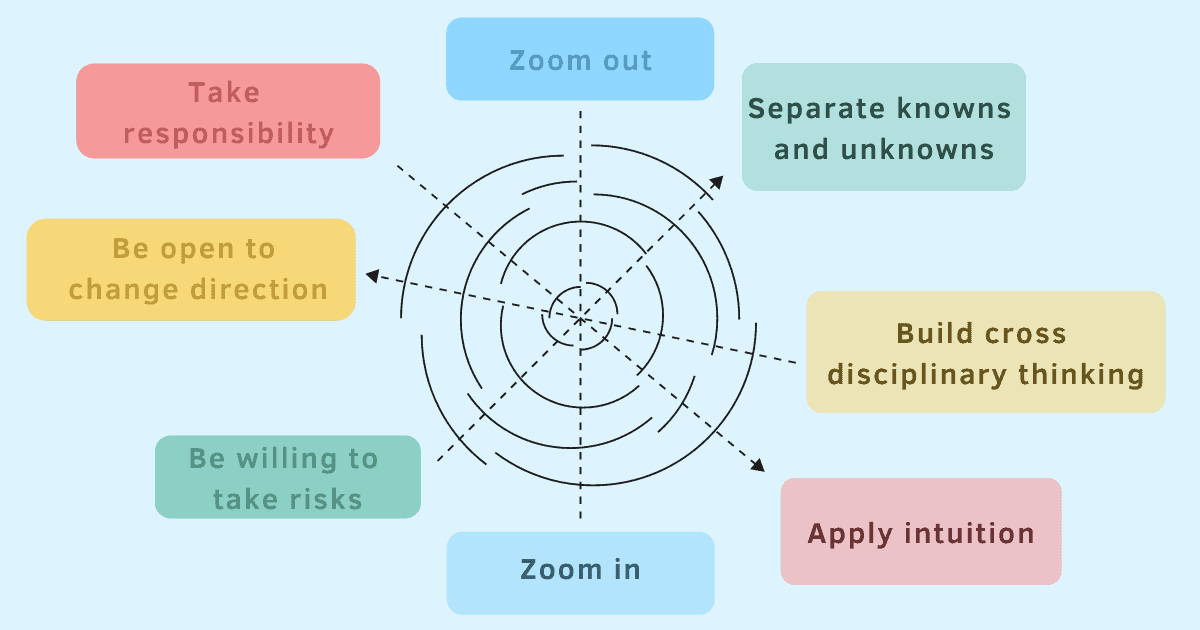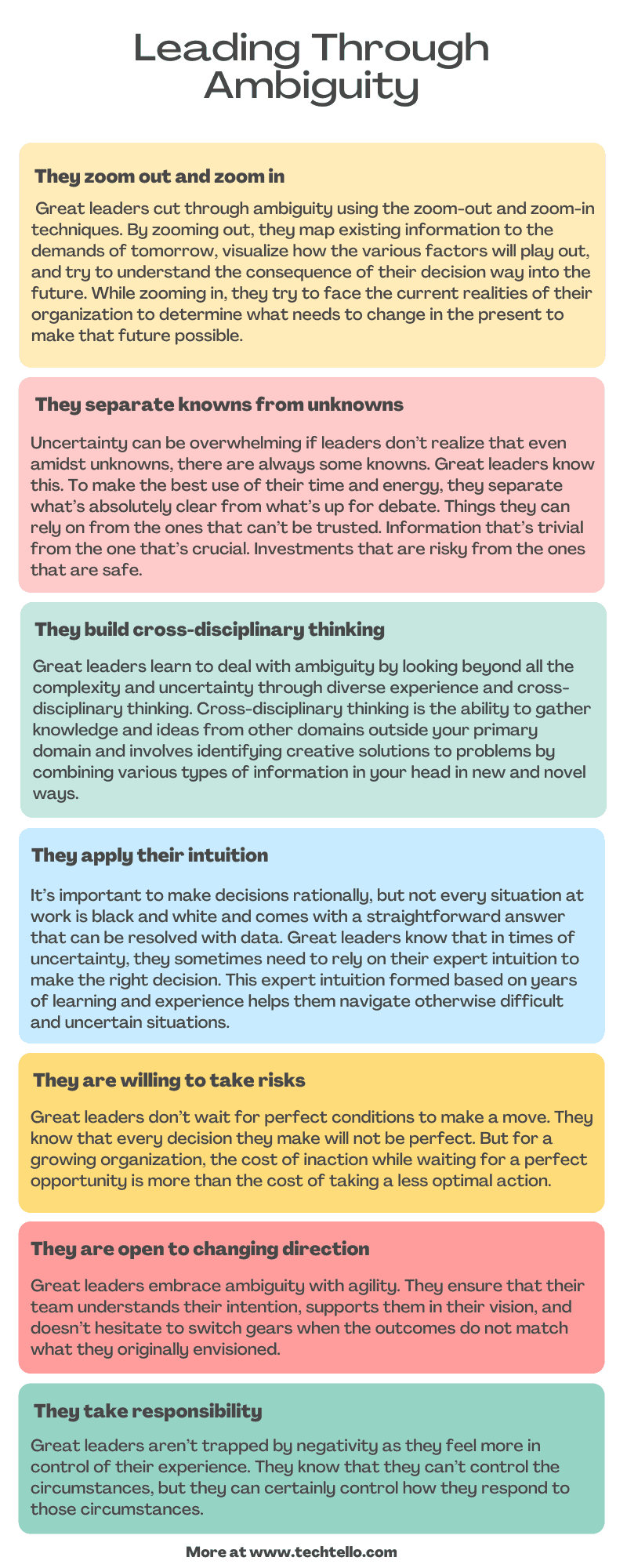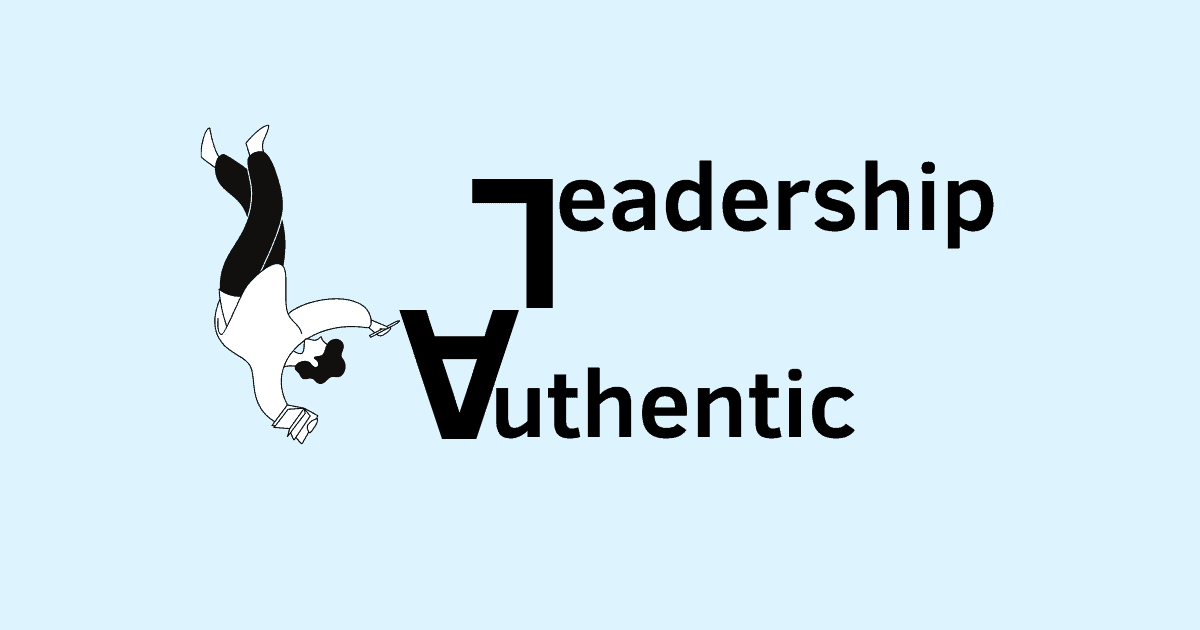How Great Leaders Deal With Ambiguity

At times, I wonder what life would be like if we knew everything beforehand. Every decision we made turned out in line with our expectations. Every outcome was guaranteed. No unknowns. No unexpected conditions. No unwarranted circumstances.
Pretty boring, right?
After all, as a species, we are designed to thrive in uncertainty. We don’t find joy in the knowns. It’s the thrill of navigating the unknowns that keep us inspired and motivated. What gives us pleasure is not the successful outcome, but getting past the obstacles and challenges we faced which led to that outcome.
Without the ability to deal with ambiguity, we wouldn’t have survived as a species. All the technology that’s now a big part of our life wouldn’t even exist. If you think about all the innovation of the last 200 years, it wasn’t born out of our comfort zone.
Every new advancement came with someone who was willing to step outside their comfort zone. Someone who made decisions without accurate information. Someone who stepped up and embraced unpredictability. Someone who navigated through change. Someone who led with a vision even without complete information.
Organizations that thrive are run by leaders who see opportunity in uncertainty, who cut through ambiguity, and those who lead with the mindset to gain clarity. As David McRaney writes in You Are Not So Smart “Remember most of the future is unforeseeable. Learn to coexist with chaos. Factor it into your plans. Accept that failure is always a possibility, even if you are one of the good guys; those who believe failure is not an option never plan for it. Some things are predictable and manageable, but the farther away in time an event occurs, the less power you have over it.”
Done right, ambiguity can be exhilarating, rewarding, and mentally stimulating. Done wrong, it can be exhausting, emotionally consuming, and even downright demotivating.
When faced with complex challenges and uncertain outcomes, many leaders rely on their brilliance or hard work to find the right answers. However, they fail to realize that navigating the unknown isn’t about smartness, and putting in more effort won’t solve increasingly complex business problems.
It’s only by considering different perspectives, asking better questions, and learning from their own systems, leaders can build the curiosity and flexibility required to purposefully cut through ambiguity.
Great leaders deal with ambiguity using these 7 practices
1. They zoom out and zoom in
Great leaders cut through ambiguity using the zoom-out and zoom-in techniques.
By zooming out, they map existing information to the demands of tomorrow, visualize how the various factors will play out, and try to understand the consequence of their decision way into the future.
While zooming in, they try to face the current realities of their organization to determine what needs to change in the present to make that future possible.
By combining the opportunities in the future with the challenges of the present, they are able to realistically carve out a plan, set deterministic goals, and take small steps to turn them into success stories for their organization.
Ambiguity can often cause leaders to zoom out and zoom in on the wrong problems. To avoid sidelining the problems that often plague their organization, great leaders create a culture where people feel safe to speak up, actively encourage disagreements and lead with the mindset to get to the right information even if it misaligns with their current beliefs and expectations.
2. They separate knowns from unknowns
Uncertainty can be overwhelming if leaders don’t realize that even amidst unknowns, there are always some knowns.
Great leaders know this. To make the best use of their time and energy, they separate what’s absolutely clear from what’s up for debate. Things they can rely on from the ones that can’t be trusted. Information that’s trivial from the one that’s crucial. Investments that are risky from the ones that are safe.
For example, every new product launch often comes with a certain degree of risk. How customers will react to the new product is always unknown. However, believing in your team and knowing that you can count on them to pull through any challenge and setback at work can be known to you. This knowledge can serve as a great source of energy to navigate uncertain times.
When deciding on two equally good opportunities, you might understand the value addition they both bring to your ecosystem but feel challenged when it comes to understanding their limitations. Knowing this can help you double click on their limitations to make a more informed decision.
3. They build cross-disciplinary thinking
No doubt some problems are complex, but even others that aren’t may seem so if leaders don’t invest in building cross-disciplinary thinking.
Cross-disciplinary thinking is the ability to gather knowledge and ideas from other domains outside your primary domain and involves identifying creative solutions to problems by combining various types of information in your head in new and novel ways.
“Increasing specialization has created a system of parallel trenches in the quest for innovation. Everyone is digging deeper into their own trench and rarely standing up to look in the next trench over, even though the solution to their problem happens to reside there,” writes David Epstein in, Range.
He adds “Modern work demands knowledge transfer: the ability to apply knowledge to new situations and different domains. Our most fundamental thought processes have changed to accommodate increasing complexity and the need to derive new patterns rather than rely only on familiar ones. Our conceptual classification schemes provide a scaffolding for connecting knowledge, making it accessible and flexible.”
Great leaders learn to deal with ambiguity by looking beyond all the complexity and uncertainty through diverse experience and cross-disciplinary thinking.
4. They apply their intuition
Amazon Prime Membership and Fulfillment by Amazon, now highly successful programs had a high probability of failure during the ideation phase.
Jeff Bezos called them radical ideas and talked about the importance of intuition in decision-making. He said “We invested in both of these ideas with a significant financial risk and after much internal debate. We had to continue investing significantly over time as we experimented with different ideas and iterations. We could not foresee with certainty what those programs would eventually look like, let alone whether they would succeed, but they were pushed forward with intuition and heart, and nourished with optimism.”
He also said “All of my best decisions in business and in life have been made with heart, intuition, guts… not analysis. If you can make a decision with analysis, you should do so. But it turns out in life that your most important decisions are always made with instinct and intuition, taste, heart.”
It’s important to make decisions rationally and factoring data into decision-making is crucial as well, but not every situation at work is black and white and comes with a straightforward answer that can be resolved with data.
Great leaders know that in times of uncertainty, they sometimes need to rely on their expert intuition to make the right decision. This expert intuition formed based on years of learning and experience helps them navigate otherwise difficult and uncertain situations.
As Colin Powell writes in It Worked for Me “Superior leadership is often a matter of superb instinct. When faced with a tough decision, use the time available to gather information that will inform your instinct. Learn all you can about the situation, your opponent, your assets and liabilities, your strengths and weaknesses, the threats and risks. Select several possible courses of action, then test the information you have gathered against them and analyze one against the other. Often, the factual analysis alone will indicate the right choice. More often, your judgment will be needed to select from the best courses of action. This is the moment when you apply your instinct to smell the right answer. This is where you apply your education, experience, and knowledge of external considerations unfamiliar to your staff. This is when you look deep into your own fears, anxiety, and self-confidence. This is where you earn your pay and position. Your instinct at this point is not a wild guess or a hunch. It is an informed instinct that knows from long experience which facts are the most important and which adverse facts, however adverse, can be set aside.”
5. They are willing to take risks
Robert Iger writes in The Ride of a Lifetime “Don’t be in the business of playing it safe. Be in the business of creating possibilities for greatness. People sometimes shy away from big swings because they build a case against trying something before they even step up to the plate. Long shots aren’t usually as long as they seem. With enough thoughtfulness and commitment, the boldest ideas can be executed.”
Great leaders don’t wait for perfect conditions to make a move.
They know that every decision they make will not be perfect. But for a growing organization, the cost of inaction while waiting for a perfect opportunity is more than the cost of taking a less optimal action.
They understand that taking risks does not mean flying blind. It involves the willingness to do experimentation, making calculated investments, checkpointing, learning, and making corrections along the way.
It’s this willingness to step into the unknown that makes them stand out from many others who feel paralyzed with ambiguity, overthinking, and indecision.
6. They are open to changing direction
It’s one thing to be invested in a decision and it’s another to be delusional.
Uncertainty may cause leaders to invest in sunk costs – invested time, money, and effort that is now irrecoverable impacts their thinking and makes them put in more resources on an already failed cause without realizing the opportunity cost of making those investments.
As Annie Duke writes in Thinking in Bets, “Our narrative of being a knowledgeable, educated, intelligent person who holds quality opinions isn’t compromised when we use new information to calibrate our beliefs…There is no sin in finding out there is evidence that contradicts what we believe. The only sin is in not using that evidence as objectively as possible to refine that belief going forward.”
Great leaders embrace ambiguity with agility. They ensure that their team understands their intention, supports them in their vision, and doesn’t hesitate to switch gears when the outcomes do not match what they originally envisioned.
Instead of sticking to an already failed course of action, they are quick to reevaluate circumstances, shift direction, and switch to a different plan of action. Flexibility to adapt, either as a response to a wrong strategy or unexpected conditions keeps their organizations strong and thriving.
7. They take responsibility
Uncertainty can create a sense of loss of control where you start believing something beyond you as the reason for your experience.
“It didn’t work out because my client backed out at the last minute.”
“If only my boss was more caring, I could have conveyed bad news sooner.”
“We didn’t do it because of lack of resources.”
Abdicating responsibility and blaming outside forces (other people, situations, circumstances) for how something turned out only leads to avoidance and inaction. When leaders engage with a victim mindset, instead of putting effort into seeking clarity, they pull back. Instead of investing time in finding a solution, they spend more time complaining and feeding their frustration which leads to a toxic spiral of negativity and inaction.
Great leaders aren’t trapped by negativity as they feel more in control of their experience. They know that they can’t control the circumstances, but they can certainly control how they respond to those circumstances. With an inner sense of control over their own behaviors, decisions, and actions, they lead with constructive action as opposed to blaming someone or something else for their situation.
Summary
- Leaders who learn to deal with ambiguity thrive while those who don’t, barely survive.
- Instead of trying to avoid uncertainty, great leaders embrace it by considering different perspectives, asking better questions, and learning from their own systems.
- With their ability to zoom in and zoom out, great leaders are able to carve out a path from the present realities of their organizations to the expectations of tomorrow.
- Separating the knowns from the unknowns helps them direct their time and energy in identifying relevant and missing information.
- Great leaders are able to look beyond the complexity and ambiguity by practicing cross-disciplinary thinking and using creative problem-solving.
- Instead of only relying on data to make decisions, they make ambiguous decisions by factoring in their intuition.
- Willingness to step outside their comfort zone makes them embrace risks and uncertainty with courage and action.
- Instead of sticking with a wrong decision, they don’t hesitate to change direction.
- Most importantly, taking responsibility puts them in control thereby enabling them to take constructive action and influence a positive change in their circumstances and conditions.






























